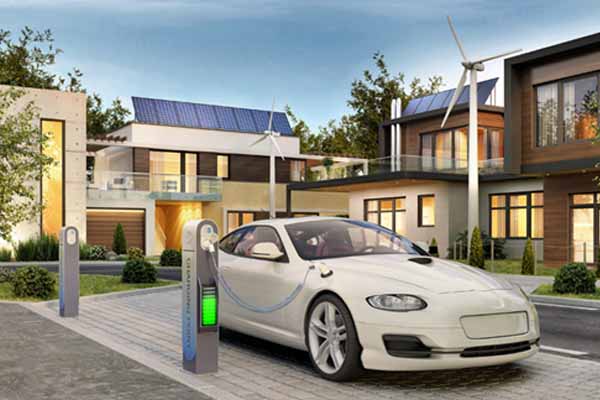Owners of EVs are keen to see a reduction in vehicle idle time, especially for long-distance driving. To achieve the EV Battery fast-charging end-users expect, it is necessary for EV automotive designers to increase charger power output, power density, and efficiency. Single-unit, charger designs currently range from 7 kW to 30 kW. As the goals of the charger manufacturers are a smaller footprint, higher flexibility, and scalability, single-unit assemblies are combined into modular designs to increase power output to help them achieve their goals. Advanced isolated packaging can be used for the active power components as it addresses the high-power charging challenges by enabling higher power density and significantly reducing the efforts in thermal management in circuit designs.
With the result that charging EV batteries increase EV usage, electric utilities have the additional challenge of managing large loads and are investigating two vehicle-to-grid technologies:
- V1G is the technology known as smart charging. In this technology, the utilities individually distribute the energy to minimize demand peaks either by controlling the time when charging an EV starts, or controlling the magnitude of power supplied.
- V2G is the bi-directional charging that controls the charging time, power, and direction. For instance, to reduce peak demand, the utility could pull some power from a fully charged battery back to the power grid to supply it to another vehicle.
Many consider contributing to peak-shaving a valuable opportunity and, V2G approach can be very cost-efficient for vehicle fleets. A case in point of this is most school buses run only during the day and are available for charging and sharing power all night. A more extensive fleet, for example, the 500,000 school buses operated in the United States, could be used as highly decentralized energy storage. The accessible battery capacity can grow to a regime of GWh during US summer vacation idle time. Today’s designers need to develop bi-directional chargers, that can also supply energy to the power grid, to accommodate the V2G technology.
More complex and requiring more components,than uni-directional chargers, bi-directional designs, need additional effort to manage power dissipation and develop sophisticated control algorithms.
The requirement of handling higher power is advanced packaging of high-power semiconductors
In Figure 1, you can find a bi-directional power supply topology that employs 16 SiC power MOSFETs in sets of eight half-bridges. Electronics designers can use more discrete power FETs in parallel to attain higher power. Nevertheless, this complicates the design of the power-electronic system. The discrete power FET packaging is usually a D²PAK or a TO-247 package. Advanced isolated packaging is designed for power levels exceeding 30 kW; it provides components supporting the required high-output power.

Multiple packages are mounted onto a common heatsink by isolated packages that contrast with discrete packages. As isolated packages are low profile, they offer a more compact design by minimizing the overall height of the subunit, when compared to their 12- or 17-mm power-module counterparts. Furthermore, when you use a top-cooling side featuring high insulation strength, you do not need additional isolation foil between the device and the heatsink. It makes the assembly process easier and less costly.
In figure 2, there is an example of the packaging options and their power handling capability. There are various criteria for these packaging options, including the output power and thermal dissipation as well as the printed circuit board (PCB) layout complexity and assembly difficulty. The designer is provided with the best combination of power capability, power dissipation, and ease of layout and assembly by the surface-mounted power device (SMPD).

SMPD Packaging Execution for Higher Power Density
To house various chip technologies, EV charging system designers can use SMPDs to incorporate various voltage classes and circuit topologies, including half-bridges. An example of SMPD packaging is shown in Figure 3. The features of the SMPD are as follows:
- Direct Copper Bonded (DCB) substrate with a copper lead frame,
- aluminum bond wires, and
- a plastic molding compound around the semiconductor.
Offering high isolation strength, the DCB structure enables a multi-semiconductor arrangement with high thermal dissipation capabilities on a single carrier. The DCB has set an exposed copper layer to maximize the available surface area for a heat sink connection. Combined with aluminum bond wires, a copper lead frame makes simplified soldering and assembly possible.

In this example, the SMPD package is designed to offer several advantages:
- UL-recognized, insulation voltage rating up to 2500 V
- Compared to other semiconductor packaging, such as TO-style devices, its thermal resistance is lower.
- SMPD provides a higher current carrying capacity than that is available with TO-style packages.
- Because of low parasitic coupling capacitance between the semiconductor die and the heatsink, its radiated EMI is reduced.
- Utilization of the semiconductor’s capabilities and low voltage overshoot is maximized, resulting from the package’s low stray inductance.
- Greater flexibility in enabling customized topologies, including thyristors, power diodes, MOSFETs, and IGBTs.
- Due to the isolated backside, all power semiconductors can mount onto a single heat sink.
In Figure 4, we can find that the SMPD package is available in two versions, SMPD-X and SMPD-B. The SMPD-X contains a single switch, single diode, or Co-Pack to cover higher power demand in one package. Building blocks are allowed by SMPD-B to have a wide variety of voltages, currents, and technologies, for example, MOSFETs, IGBTs, and thyristors in a variety of topologies.

Sharing a common footprint and mounting area, both versions have the same package dimensions of 25 mm length and 23 mm width.
Built with two Height-Units (2HU) and a length of 880 mm for EV charging subunits, a 19-inch rack is universal in the industry. While the design uses low-profile SMPD packages as an example, it exhibits roughly a 13 percent volume saving compared to E2, and E3 Package in a 19-inch 2HU rack configuration. It will make more space for passive components such as power magnetics and decoupling capacitors.
In figure 5, almost half of the number of components is reduced by SMPD packaging. If we reduce the number of components required, it will enhance power density, higher power, and reduce the overall assembly size. Each package shown in Figure 5 contains two power MOSFETs. This is one example of multiple circuit configurations that are available in SMPD packaging.

If we even target higher power levels, we can also find the SMPD available with single-switch arrangements for IGBT and SiC MOSFETs. When designs require higher voltages, package options up to and exceeding 1700 V are readily available.
The aim we target is: Smaller packages with higher power
Designers can increase the power of their EV chargers by using SMPD packaging. It will improve power density and efficiency. Without paralleling components, SMPDs let designers develop single power units with output as high as 50 kW. By using fewer components, we can use SMPD power components to help lower the manufacturing cost. Surface-mounted package designs like those from Littelfuse can minimize heatsink size and cost with low thermal resistance packaging technology. We can use this packaging to lower both radiated and conducted EMI with lower parasitic capacitance and stray inductance. Moreover, operating at higher frequencies can let the designer use smaller inductors to further save space and cost.
Bottom line: Designers can also overcome the challenges of increasing the output power without substantially increasing the size and weight of the system built by incorporating SMPD power device packaging.
About the author:
Martin Schulz and Philippe Di Fulvio, Littelfuse, Inc.















